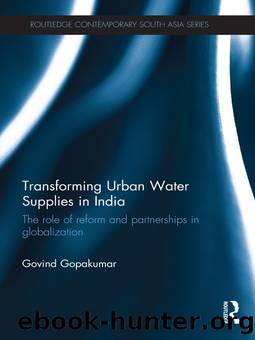Transforming Urban Water Supplies in India: The Role of Reform and Partnerships in Globalization by Govind Gopakumar

Author:Govind Gopakumar [Gopakumar, Govind]
Language: eng
Format: epub
Tags: Nature, Natural Resources, Political Science, General, Social Science, Ethnic Studies, Regional Studies
ISBN: 9781136637452
Google: O6OpAgAAQBAJ
Publisher: Routledge
Published: 2011-09-14T03:59:34+00:00
Partnerships in water supply
A recent global initiative has established a program for focusing national attention in developing countries on the brown agenda of sustainability. In 2000, the United Nations Millennium Development Goals (MDG) presented a series of ambitious targets that sought to commit individual nations to improving local environmental, economic, and social sustainability. The MDGâs tenth target seeks âto cut in half by 2015 the proportion of people without sustainable access to drinking water and basic sanitationâ (UN Millennium Project 2005). A key recommendation of the MDG was to reorient public institutions, such as utilities and public health departments, away from a traditional supply-driven logic and toward progressive partnerships with community-level institutions, small-scale private providers and vendors, and technical groups (World Bank 2004; UN Millennium Project 2005). Essentially, the MDG was calling for a paradigmatic transition in basic water and sanitary service provision. Two key points emerge from this recommendation. First, the United Nations MDG calls for a fundamental change in the water supply paradigm in order to meet the challenge of widespread absence of drinking water. Second, it suggests that the paradigm shift will require a deliberate turn away from exclusive dependence on supply-side institutions toward a partnership model involving multiple stakeholders. This goal was reaffirmed by the World Summit on Sustainable Development at Johannesburg in 2002 (United Nations 2002). The report identifies partnerships that cross the publicâprivate divide as critical to improving basic infrastructural provisions. Within the water supply sector, governments and development agencies have identified a range of partnering possibilities (Nickson 1997; Memon 2002; Franceys and Weitz 2003; Sansom 2006). These arrangements are expected to serve at least one of three strategies: (1) financing system expansion, (2) improving the efficiency of production and distribution, and (3) extending provision to unserviced zones.1
The first strategy seeks to incorporate private entities into the financing of major system enhancements and expansions. Commonly used contract methodologies such as BOT (Build, Operate, and Transfer) and BOOT (Build, Own, Operate, and Transfer) are exemplars of this initiative. The second strategy seeks to improve production/distribution efficiency through partnerships that include service and management contracts, distribution system leases, and even the sale of the supply system to private entities (World Bank 2004). A third strategy seeks to institute partnerships which enhance service coverage and provide standardized supply connectivity to neglected areas such as slums, urban peripheries, and rural regions. In this book, the focus will be on partnerships in the third strategy.
In India, water partnerships have certainly emerged in response to the MDGâs call for change. However, this change can also be attributed to the countryâs wider shift toward state withdrawal from social service provision and the greater involvement of the private sector. With the initiation of economic reforms and decentralization measures, the three aforementioned partnering strategies have become increasingly popular (Kundu 2002). Partnerships are an accepted method of addressing the widespread inadequacy of water supply connectivity. Seeing the failure of wholesale privatization of water supply in many regions of the developing world in the 1990s,
Download
This site does not store any files on its server. We only index and link to content provided by other sites. Please contact the content providers to delete copyright contents if any and email us, we'll remove relevant links or contents immediately.
| Automotive | Engineering |
| Transportation |
Whiskies Galore by Ian Buxton(41561)
Introduction to Aircraft Design (Cambridge Aerospace Series) by John P. Fielding(32906)
Small Unmanned Fixed-wing Aircraft Design by Andrew J. Keane Andras Sobester James P. Scanlan & András Sóbester & James P. Scanlan(32589)
Craft Beer for the Homebrewer by Michael Agnew(17953)
Turbulence by E. J. Noyes(7733)
The Complete Stick Figure Physics Tutorials by Allen Sarah(7162)
Kaplan MCAT General Chemistry Review by Kaplan(6628)
The Thirst by Nesbo Jo(6473)
Bad Blood by John Carreyrou(6295)
Modelling of Convective Heat and Mass Transfer in Rotating Flows by Igor V. Shevchuk(6244)
Learning SQL by Alan Beaulieu(6056)
Weapons of Math Destruction by Cathy O'Neil(5872)
Man-made Catastrophes and Risk Information Concealment by Dmitry Chernov & Didier Sornette(5687)
Digital Minimalism by Cal Newport;(5416)
Life 3.0: Being Human in the Age of Artificial Intelligence by Tegmark Max(5211)
iGen by Jean M. Twenge(5187)
Secrets of Antigravity Propulsion: Tesla, UFOs, and Classified Aerospace Technology by Ph.D. Paul A. Laviolette(5071)
Design of Trajectory Optimization Approach for Space Maneuver Vehicle Skip Entry Problems by Runqi Chai & Al Savvaris & Antonios Tsourdos & Senchun Chai(4859)
Electronic Devices & Circuits by Jacob Millman & Christos C. Halkias(4766)
